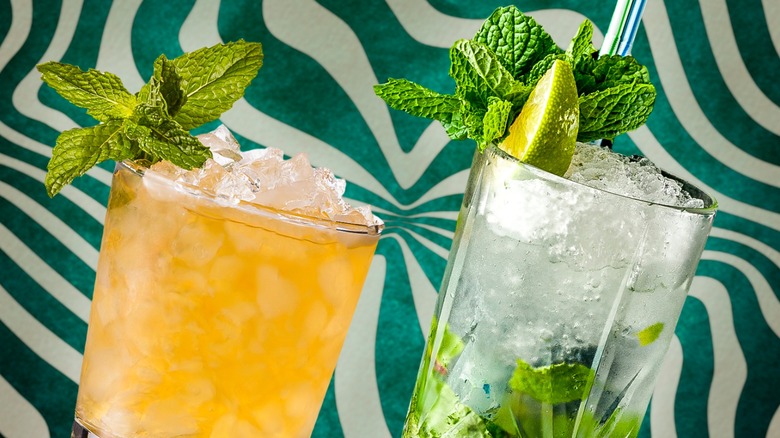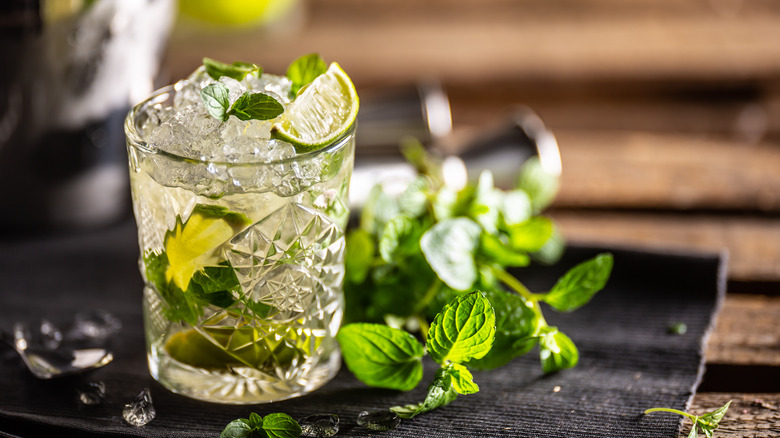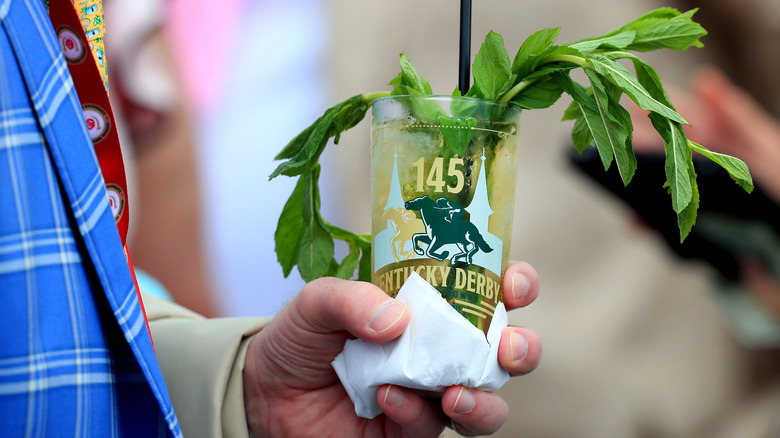Mint Julep Vs Mojito: What's The Difference?
It would feel inappropriate to discuss the mint julep at any length without mentioning the Kentucky Derby. In his iconic 1970 essay "The Kentucky Derby Is Decadent and Depraved," Hunter S. Thompson recounts a visit to the annual horse race, rolling into the scene hot and thirsty. He's ready for a stiff cocktail, but a local discerning drinker steers his order in the right direction: "'I'm ready for anything, by God! Anything at all. Yeah, what are you drinkin?' I ordered a Margarita with ice, but he wouldn't hear of it: 'Naw, naw ... what the h*ll kind of drink is that for Kentucky Derby time? What's wrong with you, boy?' He grinned and winked at the bartender. 'God**m, we gotta educate this boy. Get him some good whiskey.'"
When it comes to a starkly similar mint-lime cocktail — the mojito — the drink's history might jump to mind less immediately. Per the lore, Ernest Hemingway, another prolific writer, was an avid mojito fan during his famous extended visits to La Bodeguita del Medio bar in Havana. Beyond that, many fans might not consider the mojito as much more than a poolside bevy. Still, as different as an American Deep South classic and a Havana sipper may seem, these two drinks bear nearly identical ingredients and preparations. The largest factor that sets these two mint-lime pillars apart is that mint juleps use a base spirit of bourbon while mojitos use rum.
What is a mint julep?
To make a long story short, mint juleps get around. The cocktail is a staple at the racetrack, but you can also find mint juleps on the menu at Michelin Guide sweetheart Eleven Madison Park in Manhattan and as a favorite drink of Food Network celebrity chef Kardea Brown. It's a lot of hoopla, albeit well-deserved, for a simple lineup of ingredients: Bourbon, sugar, mint, and crushed ice. Some folks also add a dash of Angostura bitters. The result is a stiff, straightforward sipper with a sweet, smoky, herbaceous flavor profile designed for slow sipping.
Mint juleps are traditionally served in designated pewter "julep cups" and garnished with mint sprigs dusted with icing sugar. To assemble, the mint leaves get muddled in the bottom of the silver julep cup, and the remaining ingredients are poured on top, stirring to mix. More traditional mixologists wet-shake all the ingredients separately and strain them into the tin cup, which should be chilled and filled halfway with crushed ice. Then, the mint julep is stirred with a bar spoon, and the cup is filled to the brim with more crushed ice. This drink is also where the julep strainer bartending tool got its name.
What is a mojito?
Not too different from the mint julep, mojito cocktails combine sugar, mint, lime, and white rum, then some club soda for a fizzy finish. To assemble, the fresh mint and simple syrup are muddled in the bottom of a cocktail shaker and then topped with lime juice, rum, and ice. The cocktail is shaken and strained into an ice-filled highball glass, then topped with club soda and more mint leaves to finish. Other bartenders skip the shaker and muddle the mint leaves directly in the bottom of the serving glass, then add the remaining ingredients and stir to combine. Mojitos are served in a tall Collins or highball glass to allow adequate room for the club soda. By contrast, mint juleps do not include a mixer, relying solely on the crushed ice for body and dilution.
Mojitos are typically made with unaged white rum, but can also be made with spiced rum for a slight yet impactful flavorful kick. Naturally sweet, accessible rum makes for a bright, refreshing, sweet but not sugary cocktail. Mojitos also allow for creative variations like the addition of pureed fresh fruit. Strawberry, pineapple, watermelon, and blackberry mojitos are popular fruity facelifts.
Mint juleps are darker and stronger than mojitos
The primary difference between these classic, refreshing minty cocktails is that mint juleps are made with bourbon whiskey and mojitos are made with rum. The white rum lends a bright, crisp flavor compared to the bourbon's smoky depth. On a similar note, one of the most crucial elements in a mint julep (but less so for a mojito) is an invisible one: Temperature.
Frostiness is key for enjoying a mint julep, which is why the ice must be abundant and crushed, and why mint juleps are traditionally served in frosty silver cups. That way, sippers can hold the drink from an affixed handle or loosely clutch it by the rim to avoid heating the cup with their hand. The increased surface area of the crushed ice provides faster dilution, which is key for making this bourbon-forward drink palatable. Conversely, ice shape matters less in a mojito, which includes other flavorful ingredients and relies less on dilution.
Another key difference is strength. Mint juleps are five parts bourbon, one part simple syrup, and lots of fresh mint leaves. For reference, a standard shot is 1 ½ ounces, and there are about 2 ½ ounces of bourbon in a mint julep, making for a formidable 28% ABV. This cocktail also provides a great opportunity to showcase your highest quality high-proof bourbon, 80 to 90 proof is ideal and ensures the drink isn't diluted too quickly. By stark contrast, mojitos clock in at a tamer 13% ABV.
Mojitos are a Cuban classic
Mojitos are Cuban in origin, descending from another cocktail named after the English explorer Sir Francis Drake, who set foot in Havana in 1586. It was an unsuccessful invasion (the crew had scurvy and dysentery), yet it still inspired the "El Draque," a drink combining lime, mint, sugar, and aguardiente, a proto-rum made from sugar cane. Whether intentional or incidental, in a triumphant roundabout reversal of the would-be invasion, El Draque showcased Cuban-indigenous ingredients, celebrating the island nation's citrus and sugarcane crops. The drink began as a medicinal tonic, but folks quickly learned that the refreshing bevy was more than practical.
Mojitos broke into the American cocktail scene when U.S. sippers jetted off en masse to Cuba during Prohibition (1920-1933). By 1932, a recipe for the "mojito" appeared in print in the Havana-based "Sloppy Joe's Bar Cocktail Manual." The name changed to mojito when the aguardiente was swapped for rum, perhaps inspired by the Spanish "mojar" meaning "wetness," or the African "mojo" meaning "to cast a spell," regarding the drink's purported medicinal qualities. To make a mojito in true Cuban style, yerba buena (spearmint) is the mint variety of choice. We also recommend using curly mint for a playful variation on the classic herby garnish. You could also make an apple cider mojito to substitute some fall vibes for the usual summer feel, but that's another story.
The mint julep's shared history with the Kentucky Derby
Perhaps even more than the bourbon, one of the most instantly recognizable aspects of the mint julep cocktail is its link to the Kentucky Derby. At Churchill Downs in Louisville, Kentucky, roughly 120,000 mint juleps are served each year over the two days of the Derby. The silver cups in which mint juleps are traditionally served are designed to resemble the Kentucky Derby trophy. Pair it with a slice of bourbon-rippled Derby Pie for an extra festive treat.
The mint julep wasn't properly ordained as the official drink of the Kentucky Derby until 1938. Its link to the Derby might have started as a utilitarian one. Mint juleps are a stiff refresher for trudging through a sweltering southern summer day. Also, during the late 1700s, the mint julep was considered a morning beverage in the southern states, which could also explain its connection to early-rising horse farmers. The mint julep first appeared in print in 1803's "Travels of Four and a Half Years in the United States of America" by John Davis, who called the cocktail a "dram of spirituous liquor that has mint steeped in it, taken by Virginians of a morning," via Liquor.com. The ice-cold whiskey cocktail has since cemented itself as a regional favorite where it remains a pillar of Kentucky culture: Horse racing, bourbon, and unhurried enjoyment.





